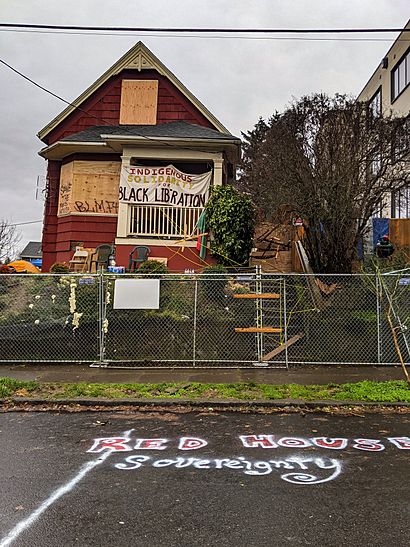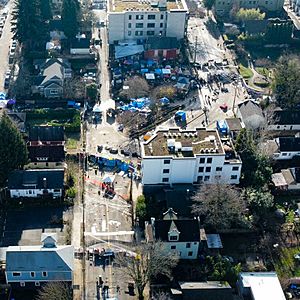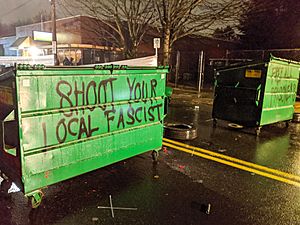Red House eviction defense facts for kids
Quick facts for kids Red House eviction defense |
|
|---|---|

The Red House, pictured on December 13, 2020
|
|
| Date | September–December 2020 |
| Location |
4406 North Mississippi Avenue,Portland, Oregon, U.S.
45°33′20″N 122°40′31″W / 45.55556°N 122.67528°W |
| Caused by | Eviction of the Kinney family |
The Red House eviction defense was a protest where people took over a house in Portland, Oregon. This house, known as the "Red House," is in a neighborhood called Humboldt, which is part of the Albina area. This area has a long history as a Black community in Portland.
The Kinney family, who are Black and Indigenous, owned the Red House for 65 years. They took out a loan on the house in the early 2000s. However, they stopped making payments on the loan in 2016. In 2018, the family lost the house through a process called foreclosure, but they continued to live there. One family member, William Kinney III, believed that the laws about debt did not apply to his family.
In September 2020, police officers came to the house with a court order and asked the Kinneys to leave. People who supported the family then gathered and took over the house and the area around it.
In December 2020, police officers returned. They removed some of the activists and arrested several people. In response, activists built barriers around the house. Police and protesters had conflicts as the police tried to clear the area.
On December 11, the Kinney family and city officials reached an agreement. The barriers were removed, and there were talks that the company that bought the house might sell it back to the Kinneys for the same price they paid. However, after raising money from supporters, the family decided to think carefully about whether to buy the house back.
Contents
Why the Red House Protest Happened
This section explains the reasons behind the Red House protest.
A Family's Home and History
The Kinney family's older son, William X Nietzche, said the house was on "unceded territory." This means land that was never officially given up by Native American tribes. He explained that gentrification is a new word for an old problem: people being forced out of their homes. This often happens when new, wealthier people move into an area, causing housing costs to rise.
He said, "It's a fight against unfair systems and gentrification that has been happening for years." He added that his family comes from this land, and it felt wrong to have it taken away.
The Kinney Family's Story
Pauline and William Kinney sold the Red House to their son, William Kinney, Jr., and his wife in 1995. His wife is from the Upper Skagit Indian Tribe. In the early 2000s, the younger Kinney family took out a mortgage on their home. They did this to pay for legal fees. The house had been in their family for 65 years by this time. They refinanced their loan in 2004.
In December 2016, their loan was moved to a different company. The family said they started getting bills from both the old and new companies. Because of this, they began putting their payments into a special account instead of paying the bills directly. This was meant to happen until the billing problem was fixed. However, news reports said it was unclear if this account was ever properly set up. The Kinney family missed 17 payments over more than a year.
During this time, the Kinneys sent messages to the lenders. They questioned if the lenders had the right to make them pay. This way of thinking is similar to the "sovereign citizen movement." People in this movement believe that many laws and courts do not apply to them. The Kinneys would mark forms "void" and send them back. They claimed the company had "no jurisdiction" over them.
William Kinney III and his mother have said in court papers and online that laws and courts do not have power over them. Experts say their words are like those used by Ammon Bundy during his protest at the Malheur National Wildlife Refuge. The Kinneys' online posts have also mentioned other ideas that are not widely accepted.
In 2018, the Kinneys owed $97,000. The house was then sold in a foreclosure sale to a developer for $260,000. The family has said it was hard to find a lawyer to help them. Often, their son, William Kinney III, had to represent them. Legal experts believe that if the Kinney family had good legal help in 2016, they might have avoided losing their home. This type of foreclosure, called "non-judicial," means a judge does not oversee the process. This means there are fewer legal protections for the homeowner.
William III, who also uses the name William X. Nietzche, has often talked about the situation online. The Kinneys have said that the mortgage company and an investment company tried to remove them from the house on purpose. They believe this was done so the land could be redeveloped. Portland Mayor Ted Wheeler had a different view. He wrote online that there was a long and fair legal process. This process led to a judge's order to evict people who were living in the home illegally.
The house has been part of legal and political actions since the foreclosure. In September, the family asked a judge to let them stay in their home. They pointed to Oregon's rule that stopped evictions during the COVID-19 pandemic. However, the courts allowed the eviction to go forward. This was because the foreclosure happened in 2018, before the pandemic started. Protesters argued that evicting people during a pandemic was still unfair. The Kinneys then stayed in hotels and with friends. Later, they moved to another home in North Portland that the elder Kinneys had owned since 1966.
The Protest and Barricades
This section describes how the protest grew and how activists created barricades.
December 2020: Protests Grow
Around 5 a.m. on December 8, 2020, the Portland Police Bureau and Multnomah County Sheriff's Office arrived. Their goal was to remove the residents, clear out belongings, and make the house unlivable. They evicted the residents and arrested seven people. Only a few protesters were there at first. The police left, and anti-eviction activists threw rocks and paint balloons. Police came back to put up a fence around the house. Protesters pushed the police back around 10:30 a.m. Several police cars were damaged, and their tires were flattened. One officer drove into a parked car while leaving.
As the day went on, about 200 activists took over the property again. They built barricades to block all ways to get to the house. Protesters closed off the intersections of North Mississippi Ave and North Albina Ave. They also blocked nearby streets like North Skidmore Street and North Prescott Street. They placed guards at the entrances to the blocked-off area.
Later on December 8, Mayor Ted Wheeler allowed the Portland Police Bureau to "use all legal ways to end the illegal occupation." He said there would be "no autonomous zone in Portland." An autonomous zone is an area where people try to create their own rules, separate from the city. He added, "It's time for the camp and occupation to end. There are many ways to protest and work for needed change. Illegally taking over private property, openly carrying weapons, threatening and scaring people are not among them." Supporters said that Mayor Wheeler's statements tried to make it seem like it was a crime for Black and Indigenous people to carry weapons. They also said that gun laws were being used more strictly against Black and Indigenous people. They stated, "We are threatened based on guesses, while known white supremacists continue to show off weapons without consequences." A representative from a group called Community Alliance of Tenants said, "This is not a story about an autonomous zone. This is a story about unfair systems."
On December 9, a local newspaper reported that guards, some of whom had weapons, were at each blocked intersection. They also said there were spike strips, which are boards with nails, outside one of the barricades. Another newspaper later said the guards were part of "several physical barricades and layers of guards." These were meant to make people of color feel safe around a fire pit in the middle of the area. That same day, the Portland Police Bureau talked about the protest being illegal and the chance of violence there. A local news outlet said the police "kept spreading scary misinformation about the occupation." On December 10, another news group reported that protesters were not allowing people to take pictures or videos inside the occupied area. Most of these disagreements were just talking, but sometimes the rule was enforced with force.
That same day, a co-owner of the company that bought the house offered to sell it back to the family. He offered it for the same price he paid in 2018. He said, "we're overwhelmed by the attention to this" and that he was worried for his family's safety. This co-owner was described as someone who buys and sells houses quickly for profit.
On December 11, district attorney Mike Schmidt praised "the neighbors and community members who refused to stay silent." He said they spoke out about what was happening. However, he also stated that some neighbors were afraid to leave their homes. He added that "continued violence, property damage, and harm to our community is unacceptable and will be dealt with strongly."
December 2020: Calming Down
The director of a group called the Coalition to Save Portland visited the Red House on December 11. He reported that the Kinney family wanted a letter. This letter would promise that people would not be arrested or charged if they helped take down the barriers. Also on the 11th, a fundraising campaign online to help the Kinney family buy back their house raised over $260,000. This was about the same amount the developer paid for it in 2018. By December 14, the amount raised was over $300,000.
Two days later, the Kinney family reached a temporary agreement with the City of Portland. This agreement would prevent the eviction if the barricades in the neighborhood were removed. The mayor and police chief also apologized for their online posts. They said that by calling the protest an "autonomous zone" and threatening protesters, they made the situation worse. This led to threats against the family.
Mac Smiff, a journalist and activist involved in the protests, called the promises and apology a rare win for protesters. He thought it would have an impact across the country. The Kinney family agreed in a statement, as did City Council member Jo Ann Hardesty and local news. In a press conference the next day, Mayor Wheeler said he was "disgusted" by the idea that his statements were a "win." He said, "we are talking about safety. And if you think that negotiating with a gun pointed at you is a win, you need to think again." He also stated that "nobody should take this as an invitation to do it anywhere else. The end result could turn out very differently."
Wheeler also announced that the Kinney family and the developer had reached a "tentative" deal. However, he later said this was not true.
After the announcement by the mayor and police chief, activists asked for help to remove the barriers. By December 14, the barriers were gone, and traffic on Mississippi and Albina avenues was back to normal.
A local newspaper said that if the street closure caused any anger among neighbors, it was not clear. They described how a local coffee shop stayed open during the protest. It let activists use their bathroom, and neighbors often bought coffee for the activists. Residents also gave materials to build the barricades. On December 17, a news channel reported that protesters were out of the street. However, some were still camping at the house and on a nearby empty lot. They said some neighbors were afraid to speak publicly. These neighbors said some protesters were still acting in a way that made them feel scared.
2021 and Beyond
As of February 20, 2021, some people, many of whom were homeless, were still camping at the property and on an empty lot next to it. Neighbors and local residents complained about being bothered, damage to property, and personal threats from the people staying there. Some emailed the city government asking for the area to be cleared. The family raised $315,000 through an online fundraising site. However, there had not yet been a deal to transfer ownership of the house. A spokesperson for the mayor said the situation was complicated because the Kinneys refused to get a lawyer.
Images for kids










